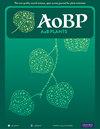Evolutionary reversal of physical dormancy to nondormancy: Evidence from comparative seed morphoanatomy of Argyreia species (Convolvulaceae)
IF 2.4
3区 生物学
Q2 ECOLOGY
引用次数: 0
Abstract
Argyreia is the most recently evolved genus in the Convolvulaceae, and available information suggests that most species in this family produce seeds with physical dormancy (PY). Our aim was to understand the evolution of seed dormancy in this family via an investigation of dormancy, storage behaviour, morphology and anatomy of seeds of five Argyreia species from Sri Lanka. Imbibition, germination and dye tracking of fresh intact and manually scarified seeds were studied. Scanning electron micrographs and hand sections of the hilar area and the seed coat away from the hilar area were compared. Scarified and intact seeds of A. kleiniana, A. hirsuta and A. zeylanica imbibed water and germinated to a high percentage, but only scarified seeds of A. nervosa and A. osyrensis did so. Thus, seeds of the three former species are non-dormant (ND), while those of the latter two have physical dormancy (PY); this result was confirmed by dye-tracking experiments. Since > 90 % of A. kleiniana, A. hirsuta and A. zeylanica seeds survived desiccation to 10 % moisture content (MC) and > 90 % of A. nervosa and A. osyrensis seeds with a dispersal MC of ~ 12 % were viable, seeds of the five species were desiccation-tolerant. A. nervosa and A. osyrensis have a wide geographical distribution and PY, while A. kleiniana, A. hirsuta and A. zeylanica have a restricted distribution and ND. Although seeds of A. kleiniana are ND, their seed coat anatomy is similar to that of A. osyrensis with PY. These observations suggest that the ND of A. kleiniana, A. hirsuta and A. zeylanica seeds is the result of an evolutionary reversal from PY and that ND may be an adaptation of these species to the environmental conditions of their wet aseasonal habitats.从物理休眠到非休眠的进化逆转:从 Argyreia 种(旋花科)种子形态解剖学比较中获得的证据
Argyreia 是旋花科(Convolvulaceae)中进化最晚的属,现有资料表明,该科的大多数物种生产的种子具有物理休眠(PY)。我们的目的是通过研究斯里兰卡五种 Argyreia 种子的休眠、贮藏行为、形态和解剖,了解该科种子休眠的进化过程。我们研究了新鲜完整种子和人工去痕种子的休眠、萌发和染料追踪。通过扫描电子显微照片和手工切片比较了种皮区和种皮远离种皮区的部分。克莱尼亚娜(A. kleiniana)、赫苏塔(A. hirsuta)和泽兰(A. zeylanica)的去痕种子和完整种子都能吸水发芽并达到很高的发芽率,但只有神仙菜(A. nervosa)和连翘(A. osyrensis)的去痕种子能吸水发芽并达到很高的发芽率。因此,前三个物种的种子无休眠(ND),而后两个物种的种子有物理休眠(PY);这一结果在染色跟踪实验中得到了证实。由于 90% 的 A. kleiniana、A. hirsuta 和 A. zeylanica 种子在含水量(MC)为 10% 的干燥条件下存活,而 90% 的 A. nervosa 和 A. osyrensis 种子在散播 MC 约为 12% 的条件下存活,因此这五个物种的种子都耐干燥。A.nervosa和A. osyrensis的地理分布广泛,PY较高,而A. kleiniana、A. hirsuta和A. zeylanica的分布有限,ND较低。虽然 A. kleiniana 的种子是玖瑰,但它们的种皮解剖结构与 A. osyrensis 的相似,都是PY。这些观察结果表明,A. kleiniana、A. hirsuta 和 A. zeylanica 种子的玖玖彩票网正规吗是PY进化逆转的结果,玖玖彩票网正规吗可能是这些物种对其潮湿季节栖息地环境条件的一种适应。
本文章由计算机程序翻译,如有差异,请以英文原文为准。
求助全文
约1分钟内获得全文
求助全文
来源期刊

AoB Plants
PLANT SCIENCES-
CiteScore
4.80
自引率
0.00%
发文量
54
审稿时长
20 weeks
期刊介绍:
AoB PLANTS is an open-access, online journal that has been publishing peer-reviewed articles since 2010, with an emphasis on all aspects of environmental and evolutionary plant biology. Published by Oxford University Press, this journal is dedicated to rapid publication of research articles, reviews, commentaries and short communications. The taxonomic scope of the journal spans the full gamut of vascular and non-vascular plants, as well as other taxa that impact these organisms. AoB PLANTS provides a fast-track pathway for publishing high-quality research in an open-access environment, where papers are available online to anyone, anywhere free of charge.
 求助内容:
求助内容: 应助结果提醒方式:
应助结果提醒方式:


